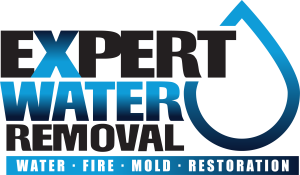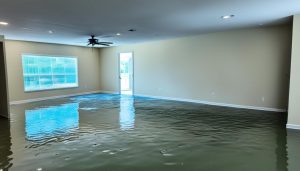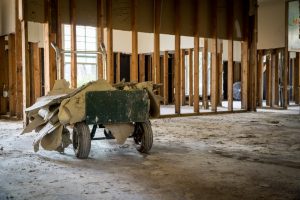Did you know the biggest risk in a flood or sewage backup isn’t disease? It’s the chance of getting electrocuted or having an explosion. This shows how vital it is to know how to clean up sewage right. Whether it’s a small spill or a big flood, doing it correctly can avoid disasters and health risks.
Sewage backups can happen to anyone. Knowing how to deal with them can make a big difference. Cleaning up sewage right means removing waste safely and keeping everything clean and safe. While experts are best for big messes, you can handle small ones yourself with the right knowledge.
Important steps include draining water, cleaning surfaces well, and using the right cleaning agents. Safety around electricity and gas is crucial. If you’re not careful, you could face serious dangers. The next parts will cover the steps and safety tips you need for this tough job.
Key Takeaways
- Greatest dangers in sewage cleanups are electrocution and explosion risks.
- Professional sewage cleanup services are recommended for extensive damage.
- For DIY sewage cleanup, thorough draining, cleaning, and sanitizing are essential.
- Always turn off electrical and gas services before beginning the cleanup.
- Sanitize with solutions like Lysol/Pine Sol or laundry bleach after cleaning.
- Consult local health agencies for guidance on food safety and further cleanup procedures.
Safety Precautions Before Cleaning Sewage
Before starting any sewage cleanup, it’s vital to take safety steps. Sewage is full of harmful stuff like bacteria and viruses. So, we must be careful to avoid health risks.
First, turn off all electrical and gas supplies to avoid fires and shocks. Wear protective gear like rubber boots, gloves, and eye protection. Also, cover any cuts or sores to prevent infections.
Good air flow is key in affected areas to avoid harmful gases. Keep kids and pets away from the area. Use a bleach and water mix (1 cup of bleach per 1 gallon of water) for cleaning. But never mix bleach with ammonia, as it can release toxic fumes.
For items like undented cans that got wet, clean them with a bleach solution. This ensures they’re safe to use. If something can’t be cleaned well, throw it away to prevent disease spread.
- Wear appropriate PPE, including rubber boots, gloves, and eye protection.
- Ensure good ventilation in contaminated areas.
- Cover cuts and sores to prevent infections.
- Keep children and pets away from affected sites.
- Use the recommended bleach and water solution for disinfection.
- Dispose of items that cannot be adequately cleaned.
- Clean undented cans with a bleach solution before use.
- Do not mix ammonia with bleach.
Following these safety steps can greatly reduce health risks. If the situation is too big for you, get help from professionals. They have the right tools and know-how to handle sewage spills safely.
Step-by-Step Cleaning and Sanitizing Procedures
Cleaning up after sewage damage needs a careful plan to keep everyone safe. It’s important to follow the right steps to avoid health risks. First, make sure pets, kids, seniors, and people with weak immune systems are out of the house.
- Begin by draining the sewage water with a pump or letting it drain naturally. Make sure to dispose of it correctly by calling local authorities.
- Put on protective gear like a face mask, rubber boots, gloves, and goggles.
- Call your insurance company to report the damage before you start cleaning.
- Get rid of anything that’s been contaminated. Clean and disinfect items that can be saved with bleach or similar products.
- Remove debris and any flooring that got damaged by the sewage.
- Use a wet vacuum to get rid of any leftover water.
- Wash walls, floors, and other affected areas with a mild detergent and hot water. Make sure to scrub them well.
- Sanitize with bleach solutions like 8 tablespoons of laundry bleach per gallon of water, or 2½ tablespoons of Lysol/Pine Sol per gallon of water.
- For food storage containers, use 1 ounce of bleach per gallon of water for cleaning.
- Open windows and doors to let the area air out for as long as you can. This helps dry the area faster and stops mold from growing.
If the damage is too much, it’s best to get help from professionals. They have the right tools and know-how to clean and sanitize properly. For expert help, think about calling Expert Water Removal for emergency sewage backups services.
Keep an eye out for mold after you’ve cleaned up. Following these steps helps keep your home safe and healthy for everyone.
Conclusion
Handling a sewage spill quickly is key to keeping people safe. A careful plan, from safety steps to cleaning, makes sure everything is safe again. For small spills, you can try DIY cleanup if you’re careful and use the right products.
But big sewage problems are serious. They can cause stomach issues, breathing problems, and skin rashes. This shows why you might need a pro to fix it.
This careful work keeps your place safe and sound. It also stops mold and checks for any damage to wires or insulation.
Acting fast and getting help from pros can make cleanup quicker. But, it’s also important to take care of your plumbing and dispose of waste right. Wearing the right gear helps keep you safe from harmful germs.
If the damage is too much, call experts like Expert Water Removal at 813.255.2910 for the Tampa Bay area. They’ll make sure your place is fixed right and you can relax knowing it’s done well.








